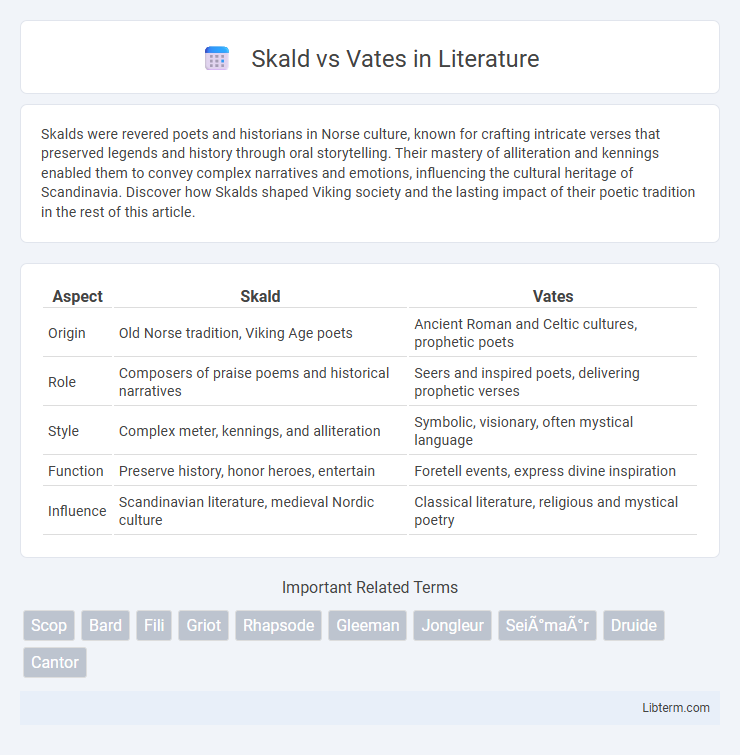Skalds were revered poets and historians in Norse culture, known for crafting intricate verses that preserved legends and history through oral storytelling. Their mastery of alliteration and kennings enabled them to convey complex narratives and emotions, influencing the cultural heritage of Scandinavia. Discover how Skalds shaped Viking society and the lasting impact of their poetic tradition in the rest of this article.
Table of Comparison
| Aspect | Skald | Vates |
|---|---|---|
| Origin | Old Norse tradition, Viking Age poets | Ancient Roman and Celtic cultures, prophetic poets |
| Role | Composers of praise poems and historical narratives | Seers and inspired poets, delivering prophetic verses |
| Style | Complex meter, kennings, and alliteration | Symbolic, visionary, often mystical language |
| Function | Preserve history, honor heroes, entertain | Foretell events, express divine inspiration |
| Influence | Scandinavian literature, medieval Nordic culture | Classical literature, religious and mystical poetry |
Introduction to Skald and Vates
Skald and Vates both represent vital roles in ancient Norse and Roman cultures, serving as poets and seers respectively. Skalds were skilled Norse poets who composed and recited intricate verses, preserving history and mythology through oral tradition. Vates, in Roman context, functioned as prophetic poets who conveyed divine messages and inspired religious and political insights.
Historical Origins of Skald and Vates
Skalds emerged in medieval Scandinavia as poet-historians who composed and recited skaldic poetry to preserve Norse legends and heroic deeds. Vates, originating in ancient Rome, were prophetic poets and religious seers tasked with interpreting divine will through ritualistic verses and omens. Both Skalds and Vates played crucial roles in their respective cultures by blending oral tradition with spiritual or historical function, reflecting the values and beliefs of their societies.
Cultural Contexts: Norse vs Celtic Traditions
Skalds in Norse culture functioned as court poets, preserving history and mythology through complex kennings and alliterative verse that celebrated heroic deeds and gods like Odin and Thor. Vates in Celtic tradition served a broader spiritual role as seers and bards, intertwining poetry with prophecy and ritual, deeply connected to druids and the sacred natural world. Both poetic figures reflect their societies' values, with Norse Skalds emphasizing honor and lineage, while Celtic Vates highlight mysticism and the divine influence on communal life.
Roles and Functions in Society
Skalds served as poets and historians in Norse society, composing epic poems that preserved the deeds of kings and heroes while reinforcing social values and cultural identity. Vates, often linked to prophetic roles, functioned as seers or diviners, providing spiritual guidance and interpreting omens to influence political and religious decisions. Both played crucial roles in maintaining societal cohesion through oral tradition, with skalds emphasizing heroic narratives and vates focusing on mystical insights.
Poetic Styles and Oral Traditions
Skaldic poetry, characterized by intricate meter and complex kennings, served as a prestigious oral tradition among Norse warriors and chieftains, emphasizing elaborate wordplay and historical narratives. Vates, rooted in ancient Roman and Celtic cultures, employed more prophetic and mystical themes, often blending spiritual insights with poetic expression during oral recitations. Both traditions relied heavily on memory and performance, yet skaldic verse prioritized formal structure while Vates poetry conveyed visionary experience and ritualistic significance.
Key Themes and Subject Matter
Skald poetry centers on heroic legends, kingship, and martial valor, emphasizing loyalty and honor within Norse society. Vates poetry, rooted in prophetic and spiritual traditions, explores themes of fate, divine inspiration, and cosmic order. Both forms reflect contrasting worldviews: Skaldic verse highlights human agency and historical deeds, while Vates verse delves into mystical knowledge and future revelations.
Methods of Composition and Performance
Skald poetry employs complex meters such as drottkvaett, characterized by intricate alliteration and internal rhyme patterns, composed orally for performance at courts and feasts to honor chieftains and commemorate battles. Vates poetry, rooted in prophetic and religious traditions, often utilizes more straightforward rhythmic structures and is composed with a focus on visionary or ritualistic purposes, sometimes recorded in chant-like forms for communal gatherings. The skaldic method emphasizes mnemonic devices and formal structures for oral recitation, while vates poetry prioritizes spiritual inspiration and improvisational expression during performance.
Influence on Later Literature and Folklore
Skald poetry, characterized by its complex meter and kennings, significantly influenced Norse sagas and medieval Icelandic literature, embedding mythological motifs and heroic themes into later literary traditions. Vates, often viewed as prophetic or inspired poets in Roman and early medieval contexts, shaped the conceptual framework of prophecy and divine inspiration in Western European folklore and literary works. Both Skaldic and Vatic traditions contributed foundational archetypes and stylistic elements that permeate contemporary storytelling and myth-making across Northern and Western Europe.
Preservation of Legacy: Texts and Artifacts
Skaldic poetry, primarily preserved through medieval manuscripts, offers intricate kennings and complex meter, playing a crucial role in documenting Norse mythology and history with precision. Vates, as prophetic poets in ancient Roman tradition, are mostly known through fragmented texts and inscriptions that convey spiritual and cultural insights, emphasizing their role in societal rituals. The preservation of both Skaldic and Vates works relies heavily on physical manuscripts, archaeological findings, and oral traditions, which together safeguard the legacy of these distinct poetic forms across centuries.
Modern Interpretations and Relevance
Modern interpretations of Skald and Vates emphasize their roles as cultural intermediaries, with Skalds representing narrative poets and Vates embodying prophetic or spiritual figures. Contemporary scholarship highlights the influence of Skaldic poetry on Icelandic identity and its preservation of Norse mythology, while Vates are often explored in the context of ancient divination and ritual practices. Their relevance persists in modern literature and popular culture, where themes of prophecy and poetic tradition continue to inspire creative expression.
Skald Infographic

 libterm.com
libterm.com